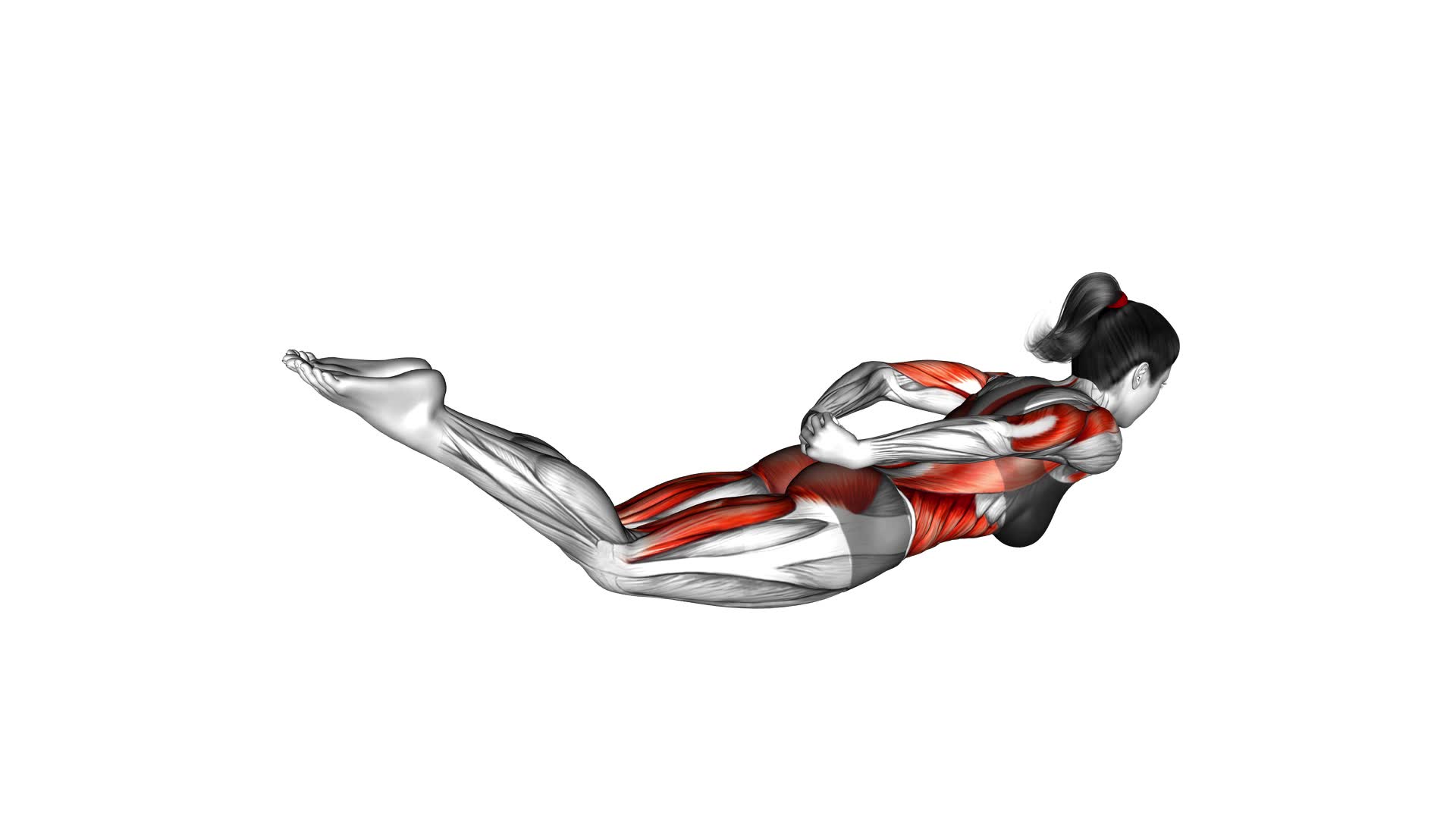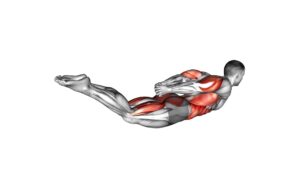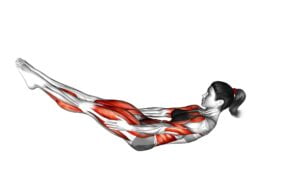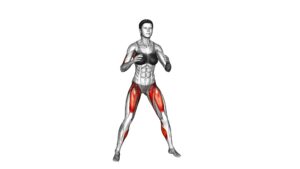Lying Double Leg Kick (female) – Video Exercise Guide & Tips

Are you looking for a challenging exercise that targets your legs and core?
Watch This Exercise Video
The lying double leg kick is here to help! This video exercise guide and tips will show you the proper form, modifications for beginners, and advanced variations for experienced fitness enthusiasts.
Avoid common mistakes and get the most out of your workout with these helpful tips.
Get ready to kick your fitness routine up a notch with the lying double leg kick!
Key Takeaways
- The lying double leg kick improves flexibility and enhances overall range of motion.
- Proper form and technique include keeping the legs straight and parallel to the ground, engaging the core for stability, and focusing on breathing.
- Leg positioning and core engagement cues involve starting in a face-down position, keeping the legs straight and together, and engaging the glutes and hamstrings.
- Breathing techniques, such as deep breathing and incorporating breathing exercises, are important for proper form and effectiveness of the exercise.
Benefits of the Lying Double Leg Kick
The lying double leg kick offers a range of benefits for those who incorporate it into their exercise routine. One of the main advantages of this exercise is its ability to improve flexibility. As you perform the lying double leg kick, you're stretching and lengthening your leg muscles, particularly the hamstrings and quadriceps. This increased flexibility can help enhance your overall range of motion, making it easier to perform other exercises or daily activities that require bending or reaching.
Another benefit of the lying double leg kick is its versatility for different fitness levels. Whether you're a beginner or an advanced exerciser, there are variations of this exercise that can be tailored to your specific needs. Beginners can start by performing the exercise with smaller movements and lower intensity, gradually working their way up to more challenging variations as they build strength and flexibility. Advanced fitness enthusiasts can incorporate additional resistance or increase the range of motion to further challenge their muscles.
Now that you understand the benefits of the lying double leg kick, it's important to learn the proper form to maximize its effectiveness and avoid injury.
Proper Form for the Lying Double Leg Kick
To perform the Lying Double Leg Kick with proper form, there are a few key points to keep in mind.
First, focus on your leg positioning by keeping your legs straight and parallel to the ground.
Engage your core muscles throughout the exercise to maintain stability and control.
Finally, pay attention to your breathing, inhaling as you lift your legs and exhaling as you lower them.
Leg Positioning Tips
Position your legs properly for the lying double leg kick exercise. Leg flexibility and muscle activation are crucial for performing this exercise correctly and effectively. Start by lying face down on a mat, with your legs straight and feet hip-width apart. Bend your knees slightly to engage your glutes and hamstrings. Place your hands under your forehead for support.
Next, inhale and lift both legs off the ground, keeping them straight and together. Exhale and kick your legs in a controlled motion, as high as you comfortably can, while maintaining proper form. Keep your core engaged and your lower back relaxed throughout the movement. Remember to focus on using your leg muscles to perform the kick, rather than relying on momentum.
Core Engagement Cues
Engage your core throughout the lying double leg kick exercise to maintain proper form and maximize the effectiveness of the movement.
Core activation is crucial as it helps stabilize your body and protect your lower back during the exercise. By engaging your core, you recruit the muscles in your abdomen, lower back, and pelvis, which work together to maintain stability and control.
To activate your core, focus on pulling your belly button towards your spine and maintaining a slight contraction in your abdominal muscles throughout the movement. This will help you maintain proper alignment and prevent any unnecessary strain on your lower back.
Breathing Techniques Explained
As you perform the lying double leg kick exercise, it's important to focus on your breathing technique to maintain proper form and maximize the effectiveness of the movement. Proper breathing can enhance your performance and help you get the most out of this exercise. Incorporating breathing exercises into your routine can also provide additional benefits, such as stress reduction and improved focus.
Deep breathing, in particular, can help increase oxygen flow to your muscles, allowing for better endurance and overall performance. By taking slow, deep breaths as you perform the lying double leg kick, you can engage your core muscles more effectively and maintain control throughout the movement.
Now, let's move on to discussing modifications for beginners, so everyone can benefit from this exercise.
Modifications for Beginners
To make the lying double leg kick exercise more accessible for beginners, you can start by using a modified version. Here are three variations for beginners to try:
- Reduce the range of motion: Instead of lifting your legs high off the ground, start by keeping your legs closer to the ground. This will help you build strength in your lower back and glutes before progressing to the full range of motion.
- Use props for support: Place a yoga block or folded towel under your pelvis to provide support and stability. This can help beginners maintain proper form and prevent strain on the lower back.
- Focus on control and technique: Slow down the movement and focus on engaging the correct muscles. Pay attention to your breathing and make sure you're using your core to control the movement of your legs.
Advanced Variations for Experienced Fitness Enthusiasts
Now let's take it up a notch for those experienced fitness enthusiasts with advanced variations of the lying double leg kick exercise. As you've mastered the basic movements, it's time to challenge yourself with advanced modifications that will push your body to new limits.
One advanced modification you can try is adding ankle weights to intensify the resistance on your legs. By increasing the weight, you'll engage your muscles even more and enhance the effectiveness of the exercise.
Another option is to use a stability ball instead of lying flat on the floor. This will add an element of instability, forcing your core muscles to work harder to maintain balance.
In addition to advanced modifications, advanced breathing techniques can also enhance the benefits of the lying double leg kick exercise. Instead of simply exhaling as you kick your legs, try incorporating a breath hold at the end of each kick. This will challenge your lung capacity and increase the intensity of the exercise.
Remember, these advanced variations aren't for the faint of heart. It's important to listen to your body and gradually progress to these more challenging variations. Always maintain proper form and technique to prevent injury.
With dedication and consistency, you'll continue to see improvements in your strength and flexibility as you take your fitness journey to the next level.
Common Mistakes to Avoid
When performing the lying double leg kick, there are some common mistakes to avoid.
One of the most important things to watch out for is incorrect body alignment, as this can put unnecessary strain on your back and neck.
Additionally, make sure to engage your core throughout the exercise to maximize its effectiveness and protect your lower back.
Lastly, pay attention to your breathing technique, as improper breathing can hinder your performance and make the exercise less efficient.
Keep these points in mind to ensure proper form and get the most out of your lying double leg kick.
Incorrect Body Alignment
Ensure proper body alignment to avoid common mistakes while performing the lying double leg kick exercise. Incorrect body alignment can lead to ineffective execution and potential strain on your muscles.
Here are three key points to keep in mind for correct body alignment:
- Maintain a neutral spine: Avoid overarching or rounding your lower back. Keep your pelvis stable and your spine in a natural alignment.
- Engage your core: Activate your abdominal muscles to stabilize your torso throughout the exercise. This helps to prevent excessive strain on your lower back.
- Align your legs and feet: Keep your legs parallel and hip-width apart. Align your feet with your hips and avoid turning them inward or outward.
Lack of Core Engagement
To avoid the common mistake of lacking core engagement during the lying double leg kick exercise, activate your abdominal muscles to stabilize your torso. Core engagement is crucial in this exercise as it helps to maintain proper form and prevent strain on your lower back.
By engaging your core, you're strengthening the muscles that surround your spine, improving your overall stability and balance. Incorporating core strengthening exercises into your fitness routine is essential for maintaining a strong and stable core. Not only does core stability enhance your performance in various exercises, but it also helps to reduce the risk of injuries.
Now that you understand the importance of core engagement, let's move on to the next common mistake to avoid: improper breathing technique.
Improper Breathing Technique
Breathe out fully while performing the lying double leg kick to avoid improper breathing technique. Proper breathing is crucial during this exercise as it helps engage your core and maximize the benefits. Here are three common mistakes to avoid when it comes to breathing technique:
- Shallow breathing: Take deep breaths that expand your chest fully. This allows for better oxygen intake and helps power your movements.
- Holding your breath: Remember to maintain a steady inhale-exhale rhythm throughout the exercise. Holding your breath can lead to tension and limit your range of motion.
- Inconsistent breathing pattern: Establish a consistent breathing pattern that coordinates with the movement. Inhale during the preparation phase and exhale as you kick your legs. This helps maintain stability and control throughout the exercise.
Tips for Getting the Most Out of Your Lying Double Leg Kick
To maximize your results, incorporate regular and consistent practice of the lying double leg kick exercise into your fitness routine. This exercise not only helps strengthen your core and lower back muscles but also enhances your flexibility.
To ensure you get the most out of your lying double leg kick, here are some tips to keep in mind.
Firstly, take advantage of the stretching benefits of this exercise. Before you begin, warm up your muscles with some dynamic stretches to increase blood flow and improve your range of motion. This will help prevent injuries and allow you to perform the exercise more effectively.
Secondly, it's crucial to focus on proper technique to avoid any potential injuries. Keep your core engaged throughout the entire exercise and maintain proper spinal alignment. Avoid straining your neck and lower back by keeping them relaxed and neutral. Additionally, be mindful of your breathing and exhale as you kick your legs up and inhale as you bring them back down.
Lastly, listen to your body and start with a modified version of the exercise if needed. Gradually increase the intensity and range of motion as you become more comfortable and stronger. Remember to always consult with a fitness professional if you have any concerns or questions about performing the lying double leg kick correctly.
Frequently Asked Questions
Can the Lying Double Leg Kick Help With Lower Back Pain?
The lying double leg kick can be helpful for lower back pain. By incorporating modifications, you can tailor the exercise to your needs.
Pilates, the practice that the lying double leg kick is a part of, is known for its benefits in relieving lower back pain. It focuses on strengthening the core and improving posture, which can alleviate strain on the lower back.
How Many Repetitions Should I Do for the Lying Double Leg Kick?
For the lying double leg kick, it's important to focus on proper form and technique.
Start by lying on your stomach and placing your hands under your chin.
Keep your legs straight and lift them off the ground while squeezing your glutes.
Then, bend your knees and kick your heels towards your glutes.
As for the number of repetitions, it depends on your fitness level and goals.
Start with 8-10 reps and gradually increase as you get stronger.
Can I Do the Lying Double Leg Kick if I Have Knee Problems?
If you have knee problems, you may need to modify the lying double leg kick exercise. It's important to listen to your body and not push past your limits.
There are alternative exercises that can be done to target the same muscle groups without putting strain on your knees.
It's always a good idea to consult with a fitness professional or physical therapist who can guide you in finding the best exercises for your specific needs.
Is It Better to Do the Lying Double Leg Kick on a Mat or on a Padded Surface?
When it comes to the lying double leg kick, you might wonder if it's better to do it on a mat or a padded surface.
Both options have their benefits.
Doing it on a mat provides a stable and firm surface, allowing you to maintain proper form and stability.
On the other hand, a padded surface offers more cushioning, reducing the impact on your knees and joints.
Choose the option that works best for your comfort and safety.
Can the Lying Double Leg Kick Help Improve My Flexibility?
The lying double leg kick is a great exercise for improving your flexibility, specifically in your hamstrings. By performing this exercise regularly, you can gradually increase your range of motion and enhance the flexibility of your leg muscles.
Additionally, the lying double leg kick has overall benefits for your flexibility, as it engages multiple muscle groups in your lower body. Incorporating this exercise into your routine can help you achieve greater flexibility and improve your overall fitness level.
Conclusion
The lying double leg kick is a challenging exercise that targets the core and lower body muscles. It offers numerous benefits, including improved strength and flexibility. By following proper form and making necessary modifications, beginners can safely perform this exercise.
Advanced variations can be incorporated to increase the intensity for experienced fitness enthusiasts. It's important to avoid common mistakes and follow tips to maximize the effectiveness of the lying double leg kick.
Overall, this exercise is a great addition to any fitness routine.

Author
Years ago, the spark of my life’s passion ignited in my mind the moment I stepped into the local gym for the first time. The inaugural bead of perspiration, the initial endeavor, the very first surge of endorphins, and a sense of pride that washed over me post-workout marked the beginning of my deep-seated interest in strength sports, fitness, and sports nutrition. This very curiosity blossomed rapidly into a profound fascination, propelling me to earn a Master’s degree in Physical Education from the Academy of Physical Education in Krakow, followed by a Sports Manager diploma from the Jagiellonian University. My journey of growth led me to gain more specialized qualifications, such as being a certified personal trainer with a focus on sports dietetics, a lifeguard, and an instructor for wellness and corrective gymnastics. Theoretical knowledge paired seamlessly with practical experience, reinforcing my belief that the transformation of individuals under my guidance was also a reflection of my personal growth. This belief holds true even today. Each day, I strive to push the boundaries and explore new realms. These realms gently elevate me to greater heights. The unique combination of passion for my field and the continuous quest for growth fuels my drive to break new ground.







